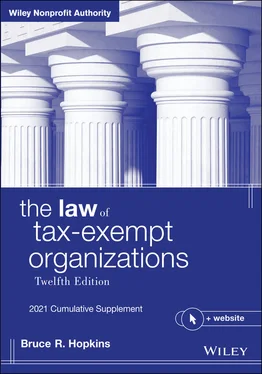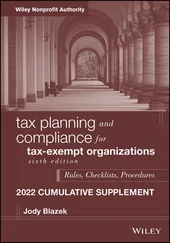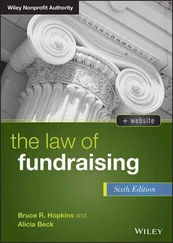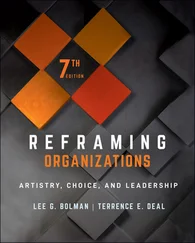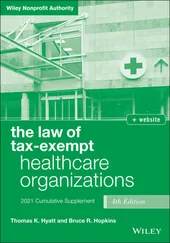Bruce R. Hopkins - The Law of Tax-Exempt Organizations, 2021 Cumulative Supplement
Здесь есть возможность читать онлайн «Bruce R. Hopkins - The Law of Tax-Exempt Organizations, 2021 Cumulative Supplement» — ознакомительный отрывок электронной книги совершенно бесплатно, а после прочтения отрывка купить полную версию. В некоторых случаях можно слушать аудио, скачать через торрент в формате fb2 и присутствует краткое содержание. Жанр: unrecognised, на английском языке. Описание произведения, (предисловие) а так же отзывы посетителей доступны на портале библиотеки ЛибКат.
- Название:The Law of Tax-Exempt Organizations, 2021 Cumulative Supplement
- Автор:
- Жанр:
- Год:неизвестен
- ISBN:нет данных
- Рейтинг книги:5 / 5. Голосов: 1
-
Избранное:Добавить в избранное
- Отзывы:
-
Ваша оценка:
- 100
- 1
- 2
- 3
- 4
- 5
The Law of Tax-Exempt Organizations, 2021 Cumulative Supplement: краткое содержание, описание и аннотация
Предлагаем к чтению аннотацию, описание, краткое содержание или предисловие (зависит от того, что написал сам автор книги «The Law of Tax-Exempt Organizations, 2021 Cumulative Supplement»). Если вы не нашли необходимую информацию о книге — напишите в комментариях, мы постараемся отыскать её.
The Law of Tax-Exempt Organizations, 2021 Cumulative Supplement — читать онлайн ознакомительный отрывок
Ниже представлен текст книги, разбитый по страницам. Система сохранения места последней прочитанной страницы, позволяет с удобством читать онлайн бесплатно книгу «The Law of Tax-Exempt Organizations, 2021 Cumulative Supplement», без необходимости каждый раз заново искать на чём Вы остановились. Поставьте закладку, и сможете в любой момент перейти на страницу, на которой закончили чтение.
Интервал:
Закладка:
The Office of Audit fiscal year 2021 Annual Audit Plan, which reflects the Treasury Inspector General for Tax Administration's (TIGTA's) current IRS audit priorities, released on October 6, 2020, includes these planned audits in the tax‐exempt organizations context: TIGTA's efforts to (1) review the Tax Exempt and Government Entities (TE/GE) Division's efforts to identify and examine exempt organizations with unreported or underreported unrelated business income tax; (2) assess whether the streamlined application for recognition of exemption results in fewer compliant tax‐exempt organizations; (3) review the IRS's policies and audit procedures to identify improper conduct by exempt organizations and determine whether the IRS has sufficient information to combat abuse and enforce federal tax laws; (4) determine the effectiveness of the Division's implementation of the Compliance Planning and Classification Unit to consolidate examination identification planning, assignment, and monitoring; (5) assess the IRS's implementation of the notice requirement for exempt organizations that have not filed an annual information return or notice for two consecutive years; and (6) provide various statistical information and data trends related to the Division.
The IRS continues to invigorate the law of tax‐exempt organizations with private letter rulings in areas such as the commerciality doctrine, nonqualification of organizations as exempt business leagues, private inurement and private benefit doctrines, the lobbying rules, and the unrelated business rules. Summaries of these and other rulings are interspersed throughout the cumulative supplement.
Courts, too, are contributing their fair share of law developments. This is particularly true in the realm of disclosure of donor and membership information. Several recent opinions on this subject, reflecting views on both sides of the issue, have been issued in recent months, such as the matter of providing Form 990, Schedule B, information to states in conjunction with fundraising regulation and disclosure of similar information in settings where free speech and privacy rights are implicated. Treasury has relieved most categories of exempt organizations of the burden of disclosing this type of information. These cases are summarized herein.
An unfortunate subject is the interplay between the law of tax‐exempt organizations and the law of tax shelters (or, if you prefer, abusive tax schemes). Interest in this area continues to grow, leading to a new chapter of the book on the point, which is included with this supplement. In fact, just as this supplement was about to be submitted to the publisher, the U.S. Government Accountability Office, in early October 2019, issued a report on this subject (summarized in this supplement).
I wish to thank my research assistant, Greg Gietzen, for his assistance in providing content material and in completing footnotes. My thanks also go to my senior editor, Brian T. Neill, and production editor, Caroline Maria Vincent, for their assistance and support in connection with creation of this supplement to accompany the book.
Bruce R. Hopkins
March 2021
About the Online Resources
The Law of Tax‐Exempt Organizations, 12th Edition 2021 Cumulative Supplement is complemented by seven online resources. Please visit www.wiley.com/go/hopkins/lawoftaxexempt12e-2021suppto download the following tables in PDF format to use alongside the 12th edition.
Cumulative Table of Cases
Cumulative Table of IRS Revenue Rulings
Cumulative Table of IRS Revenue Procedures
Cumulative Table of IRS Private Determinations Cited in Text
Cumulative Table of IRS Private Letter Rulings, Technical Advice Memoranda, and Counsel Memoranda
Cumulative Table of Cases Discussed in Bruce R. Hopkins' Nonprofit Counsel
Cumulative Table of IRS Private Determinations Discussed in Bruce R. Hopkins' Nonprofit Counsel
Book Citations
Throughout this book, 14 books by the author (in some instances as coauthor), all published by John Wiley & Sons, are referenced as follows:
1 IRS Audits of Tax‐Exempt Organizations: Policies, Practices, and Procedures (2008): cited as IRS Audits
2 The Law of Fundraising, Fifth Edition (2014): cited as Fundraising
3 The Law of Intermediate Sanctions: A Guide for Nonprofits (2003): cited as Intermediate Sanctions
4 The Law of Tax‐Exempt Healthcare Organizations, Fourth Edition (2014): cited as Healthcare Organizations
5 The New Form 990: Law, Policy, and Preparation (2009): cited as New Form 990
6 Nonprofit Governance: Law, Practices & Trends (2009): cited as Nonprofit Governance
7 The Nonprofits' Guide to Internet Communications Law (2003): cited as Internet Communications
8 Planning Guide for the Law of Tax‐Exempt Organizations: Strategies and Commentaries (2004): cited as Planning Guide
9 The Tax Law of Private Foundations, Fifth Edition (2018): cited as Private Foundations
10 Starting and Managing a Nonprofit Organization: A Legal Guide, Seventh Edition (2017): cited as Starting and Managing
11 The Tax Law of Associations (2006): cited as Associations
12 The Tax Law of Charitable Giving, Sixth Edition (2021): cited as Charitable Giving
13 The Tax Law of Unrelated Business for Nonprofit Organizations (2005): cited as Unrelated Business
14 Tax‐Exempt Organizations and Constitutional Law: Nonprofit Law as Shaped by the U.S. Supreme Court (2012): cited as Constitutional Law.
The second, fourth, ninth, and twelfth of these books are annually supplemented.
Updates on all of the foregoing subjects (plus The Law of Tax‐Exempt Organizations ) are available in Bruce R. Hopkins' Nonprofit Counsel , the author's monthly newsletter, also published by John Wiley & Sons.
CHAPTER ONE Definition of and Rationales for Tax‐Exempt Organizations
§ 1.1 Definition of Nonprofit Organization (a) Nonprofit Organization Defined
§ 1.1 DEFINITION OF NONPROFIT ORGANIZATION
(a) Nonprofit Organization Defined
p. 5, note 7. Insert prior to existing text:
This point is sometimes overstated, as illustrated by a state's supreme court's proclamation that “[n]on‐profit corporations do not have owners,” adding that “non‐profit corporations do not have shareholders or any other way for third parties (whether individuals or entities) to assert a similar ‘ownership’ role” (Farrow v. Saint Francis Medical Center, 407 S.W.3d 579, 593 (Sup. Ct. Mo. 2013)).
p. 5, note 7. Insert as second paragraph:
An individual, desiring to engage in certain activities appropriate for a nonprofit entity, formed, with advice of legal counsel, a nonprofit corporation. Matters did not go well with this entity, programmatically or financially. This individual, who was the corporation's incorporator and president, and a director, filed a retroactive election for S corporation status for the entity as of the date of incorporation. This was done in an effort to enable him to report passthrough operating losses on his personal income tax returns. To this end, he claimed that he held an ownership interest in the organization equivalent to that of a shareholder. The IRS disagreed, disallowing the passthrough losses. The U.S. Tax Court upheld the IRS's position, rejecting the argument that this individual held “exclusive beneficial ownership” of the corporation and writing that “there is no interest in a nonprofit corporation equivalent to that of a stockholder in a for‐profit corporation who stands to profit from the success of the enterprise” (Deckard v. Comm'r, 155 T.C. No. 8 (2020)).
Читать дальшеИнтервал:
Закладка:
Похожие книги на «The Law of Tax-Exempt Organizations, 2021 Cumulative Supplement»
Представляем Вашему вниманию похожие книги на «The Law of Tax-Exempt Organizations, 2021 Cumulative Supplement» списком для выбора. Мы отобрали схожую по названию и смыслу литературу в надежде предоставить читателям больше вариантов отыскать новые, интересные, ещё непрочитанные произведения.
Обсуждение, отзывы о книге «The Law of Tax-Exempt Organizations, 2021 Cumulative Supplement» и просто собственные мнения читателей. Оставьте ваши комментарии, напишите, что Вы думаете о произведении, его смысле или главных героях. Укажите что конкретно понравилось, а что нет, и почему Вы так считаете.
